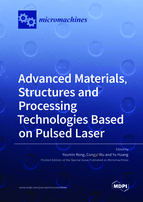Advanced Materials, Structures and Processing Technologies Based on Pulsed Laser
A special issue of Micromachines (ISSN 2072-666X). This special issue belongs to the section "E:Engineering and Technology".
Deadline for manuscript submissions: closed (31 October 2021) | Viewed by 16322
Special Issue Editors
Interests: ultra-fast laser processing; high-power laser processing; laser processing process inspection
Special Issues, Collections and Topics in MDPI journals
Interests: laser manufacturing; ultrafast laser processing; flexible electronics; polymer laser processing; flexible sensor; wearable devices; human–machine interface
Special Issues, Collections and Topics in MDPI journals
Special Issue Information
Dear Colleagues,
Pulsed lasers are lasers with a single laser pulse width of less than 0.25 s, operating only once every certain time interval. Commonly used pulsed lasers are nanosecond, femtosecond, and picosecond lasers. A pulsed laser produces short pulses with short a interaction time with the material, which can largely avoid impacts on the thermal movement of molecules and has minimal thermal impact on surrounding materials, thus having significant advantages in precision microfabrication. It is now widely used in flexible electronics, chips, medicine, and other fields, such as photographic resin curing, micro-welding, vision correction, heart stent manufacturing, etc. However, as an emerging processing technology, the application prospects of pulsed lasers have yet to be fully expanded, and there is still a need to continuously explore mechanisms of interaction with materials, manufacture advanced functional structures, and develop advanced process technologies.
This Special Issue of Micromachines, “Advanced Materials, Structures and Processing Technologies Based on Pulsed Lasers”, seeks to showcase research papers, communications, and review articles that focus on new materials, structures, and processing technologies based on pulsed lasers, exploring the application of pulsed lasers in various fields. We hope that the papers will encompass the next key technological leaps that will further extend the applications of pulsed lasers. Suitable contributions can be related to (but are not restricted to) new material pulsed laser interaction technologies, new structure pulsed laser processing technologies, new pulsed laser processing technology, and the expansion of pulsed laser applications in flexible electronics, batteries, aerospace, navigation, etc.
Dr. Youmin Rong
Dr. Congyi Wu
Prof. Dr. Yu Huang
Guest Editors
Manuscript Submission Information
Manuscripts should be submitted online at www.mdpi.com by registering and logging in to this website. Once you are registered, click here to go to the submission form. Manuscripts can be submitted until the deadline. All submissions that pass pre-check are peer-reviewed. Accepted papers will be published continuously in the journal (as soon as accepted) and will be listed together on the special issue website. Research articles, review articles as well as short communications are invited. For planned papers, a title and short abstract (about 100 words) can be sent to the Editorial Office for announcement on this website.
Submitted manuscripts should not have been published previously, nor be under consideration for publication elsewhere (except conference proceedings papers). All manuscripts are thoroughly refereed through a single-blind peer-review process. A guide for authors and other relevant information for submission of manuscripts is available on the Instructions for Authors page. Micromachines is an international peer-reviewed open access monthly journal published by MDPI.
Please visit the Instructions for Authors page before submitting a manuscript. The Article Processing Charge (APC) for publication in this open access journal is 2600 CHF (Swiss Francs). Submitted papers should be well formatted and use good English. Authors may use MDPI's English editing service prior to publication or during author revisions.
Dr. Youmin Rong
Dr. Congyi Wu
Prof. Dr. Yu Huang
Guest Editors
Manuscript Submission Information
Manuscripts should be submitted online at www.mdpi.com by registering and logging in to this website. Once you are registered, click here to go to the submission form. Manuscripts can be submitted until the deadline. All submissions that pass pre-check are peer-reviewed. Accepted papers will be published continuously in the journal (as soon as accepted) and will be listed together on the special issue website. Research articles, review articles as well as short communications are invited. For planned papers, a title and short abstract (about 100 words) can be sent to the Editorial Office for announcement on this website.
Submitted manuscripts should not have been published previously, nor be under consideration for publication elsewhere (except conference proceedings papers). All manuscripts are thoroughly refereed through a single-blind peer-review process. A guide for authors and other relevant information for submission of manuscripts is available on the Instructions for Authors page. Micromachines is an international peer-reviewed open access monthly journal published by MDPI.
Please visit the Instructions for Authors page before submitting a manuscript. The Article Processing Charge (APC) for publication in this open access journal is 2600 CHF (Swiss Francs). Submitted papers should be well formatted and use good English. Authors may use MDPI's English editing service prior to publication or during author revisions.
Keywords
- pulsed laser
- nanosecond laser
- femtosecond laser
- picosecond laser
- interaction mechanism
- functional structure
- process technology









